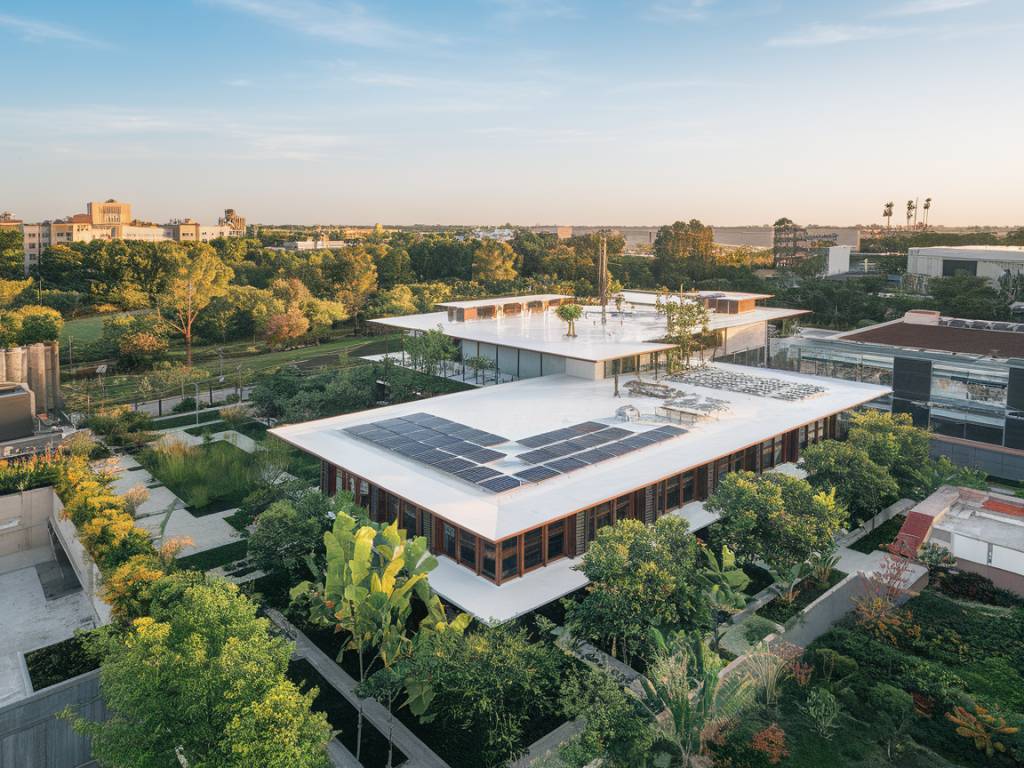What is Cool Roofing?
Imagine walking barefoot on a sun-baked asphalt road in the middle of summer. Sounds uncomfortable, doesn’t it? Traditional roofing materials like asphalt shingles and dark tiles aren’t much different; they absorb and retain heat, significantly raising urban temperatures. Cool roofing, on the other hand, takes a refreshing approach by using materials and technologies that reflect more sunlight and absorb less heat.
Cool roofs are specifically designed with a high solar reflectance (ability to reflect sunlight) and high thermal emittance (ability to release absorbed heat). This combination helps reduce the heat a building absorbs, keeping interiors cooler and reducing the surrounding urban heat. But let’s dig deeper—how does this contribute to sustainable urban living?
The Urban Heat Island Problem
Urban areas are notorious for being hotter than their rural counterparts, a phenomenon known as the Urban Heat Island (UHI) effect. Why? Buildings, asphalt roads, and other materials absorb and retain heat, replacing naturally cooler vegetation. This rise in temperature doesn’t just make cities uncomfortable; it escalates energy consumption, worsens air quality, and increases the health risks associated with heat waves.
Cool roofing plays a key role in combatting this issue. By minimizing heat absorption, cool roofs help lower the UHI effect. Less retained heat means cooler cities—a necessity as global temperatures continue to rise.
Benefits of Cool Roofing
So, what makes cool roofing a game-changer for urban sustainability? Let’s break it down:
- Reduced Energy Consumption: Cool roofs decrease the need for air conditioning by keeping buildings naturally cooler. This reduction not only cuts electricity bills but also eases the load on energy grids.
- Lower Carbon Emissions: Using less electricity means less reliance on power plants, many of which still depend on fossil fuels. As a result, cool roofing can help cut greenhouse gas emissions.
- Improved Comfort: Even buildings without air conditioning benefit from cool roofs, as they maintain a more comfortable indoor temperature.
- Enhanced Roof Longevity: Traditional roofs degrade faster due to high heat absorption. Cool roofs, by reducing heat stress, can extend a roof’s life, saving money and reducing waste.
- Mitigating the Urban Heat Island Effect: The collective impact of cool roofs across neighborhoods can help lower overall urban temperatures, improving the quality of life for city dwellers.
Innovative Materials Behind Cool Roofs
Not all roofs are created equal, and the magic of cool roofing lies in the materials used. Advanced coatings, reflective shingles, and even lighter-colored tiles are the unsung heroes of this technology. For example, a reflective cool roof coating can be applied over traditional materials to enhance their solar reflectivity. Meanwhile, modern metal roofs with reflective finishes offer sleek designs without compromising performance.
One particularly fascinating innovation is the use of « thermochromic » materials. These futuristic materials change their properties based on temperature—reflecting more sunlight when temperatures rise and absorbing more heat in colder weather. It’s like your roof having a built-in thermostat.
Cool Roofing in Action: Real-World Applications
The benefits of cool roofing aren’t just theoretical; they’re already being implemented across the globe. Take Los Angeles, for example. The city rolled out a cool pavement program, painting streets and rooftops with reflective materials. Early results showed a noticeable drop in surface temperatures, emphasizing the potential for cities to adapt this strategy.
In India, where heatwaves are becoming more intense, cool roofing has been adopted to combat life-threatening indoor temperatures in urban slums. By using simple and affordable reflective materials, these communities have experienced a remarkable transformation in their living conditions.
Even large corporations are jumping on board. Tech companies in Silicon Valley have installed cool roofs on their sprawling campuses, not just for energy savings but as part of broader sustainability goals. It’s a win-win situation for businesses and the environment.
Cool Roofing and Climate Action
When we talk about tackling climate change, discussions often revolve around renewable energy, electric vehicles, or reforestation—and rightly so. But cool roofing demonstrates that even seemingly small interventions can have a profound impact. By alleviating urban heat and reducing energy demands, cool roofs become an important tool in the fight against global warming.
The beauty of cool roofing lies in its accessibility. Retrofit projects can transform existing buildings, while new construction projects can incorporate cool roofing from the outset. Coupled with other urban sustainability measures—like green roofs and energy-efficient building designs—cool roofs can help create resilient cities prepared for the challenges of climate change.
What’s Next for Cool Roofing?
While the concept of cool roofing has made significant progress, there’s still untapped potential in terms of policy, technology, and awareness. For one, governments can scale adoption by offering tax incentives, grants, and subsidies for cool roofing upgrades. Additionally, integrating cool roofing into building codes could ensure that sustainability becomes the standard rather than the exception.
On the technological front, research continues to push the boundaries of what cool roofing materials can achieve. The development of customizable, vibrant colors for cool roofs, for instance, allows property owners to prioritize aesthetics without sacrificing performance. And as more people learn about the benefits of cool roofs, public demand can drive even greater levels of adoption.
Making Cool Roofing Your Next Step
As urbanites, homeowners, or advocates for sustainable living, we all have a role to play in creating more livable cities. If you’re considering a home improvement project, why not explore cool roofing? It’s a practical, tangible way to contribute to a cooler, greener future for your community.
It’s easy to underestimate the power of a roof—it’s something we rarely think about unless it’s leaking. But with cool roofing, your roof becomes more than just protection against rain or snow. It becomes part of a larger, sustainable solution for tackling some of the biggest challenges of our time. Ready to make the cool choice?
